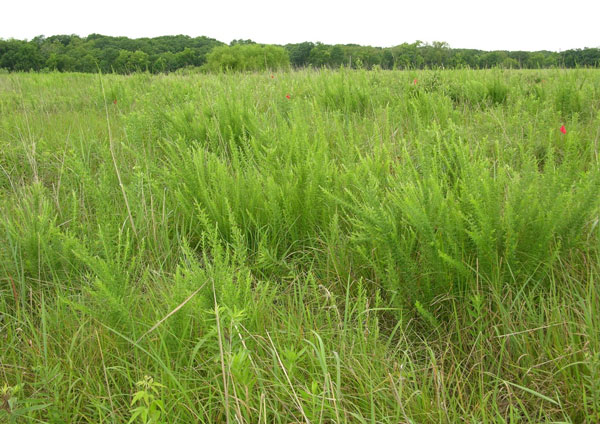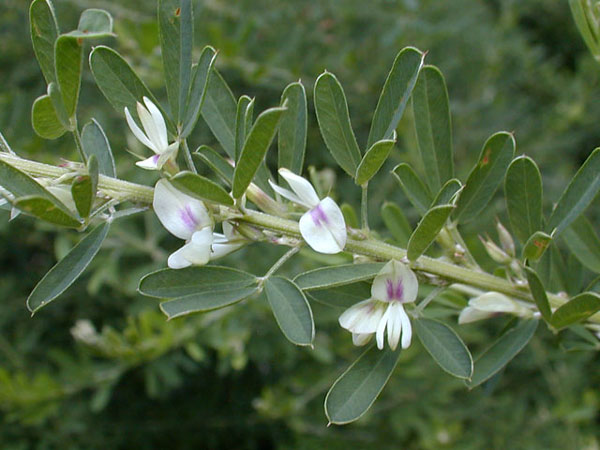Sericea lespedeza, or Chinese bush clover (Lespedeza cuneata), is the focus of this month’s World of Weeds article. A statewide noxious weed, sericea is established across the eastern third of the state and many central Kansas counties and contributes to forage loss in otherwise productive pastures and rangelands.
History
Native to eastern Asia, sericea was originally introduced to the United States in the late 1800s through the North Carolina Agricultural Experiment Station. Due to its tolerance of shallow and acidic soils, sericea was planted to stabilize strip mines, highway right-of-ways, and other highly erodible areas beginning in the 1920s. Sericea was progressively introduced into rangeland plantings in the following decades, with the expectation that it would provide forage for livestock and serve as a wildlife habitat. Sericea was increasingly recognized as a problematic species that has outcompeted native plants without providing the intended benefits of its introduction and has since been considered a noxious or invasive weed in several states.
Ecology
Sericea is a perennial, warm-season legume with woody stems and a deep taproot. Once established, mature plants are estimated to produce 1,000 seeds per individual per year, which contributes to a substantial seedbank for seedling recruitment in following years. Prescribed fire, a common management tool in grasslands, has been shown to scarify sericea seeds and promote their germination. Sericea also produces a high concentration of condensed tannins in its foliage that increases with maturity. Although also high in crude protein, these tannins make sericea undigestible for cattle except at the earliest stages of growth. The combination of low palatability and high seed production is often cited as a key factor supporting sericea’s success in outcompeting other grassland plant species.
Identification
Plants frequently branch at the base and appear bushy as they mature, growing up to five feet tall in ideal conditions and generally standing out when surrounded by grasses (Figure 1). Sericea has trifoliate leaves (3 leaflets = 1 leaf), which closely resemble other desirable native lespedeza species, especially in the early stages of growth (Figure 2). Sericea plants typically bloom beginning in June with small, cream-colored flowers dotted with a single purple patch (Figure 3).

Figure 1. Typical growth habit of established sericea in a tallgrass prairie. Photo credit: Greg Houseman.

Figure 2. Trifoliate leaves of sericea (left) and two native lespedezas commonly confused with this species, round-head bush clover (Lespedeza capitata, center) and slender leaf bush clover (Lespedeza virginica, right). Note that sericea has parallel veins while native lespedeza species have “net-like” or looping leaf venation, which can help distinguish between these species, especially in the early stages of growth. Photo credits: Hamilton Native Outpost (left), D.E. Tenaglia/Missouri Plants (center), and Peter Friedman/Wildflowers of the National Capital Region (right).

Figure 3. Sericea leaves, stems, and flowers. Photo credit: Mike Haddock/Kansas Wildflowers & Grasses.
Management
Different combinations of prescribed burning, grazing, mowing, and herbicide application can be used in conjunction to defoliate mature plants, reduce the seed set of established plants, and deplete the existing bank of sericea seeds. Although cattle are not effective grazers of sericea, goats are able to digest sericea and have been shown to readily consume its foliage. If hay is cut before sericea buds, cattle have been reported to readily consume sericea as hay.
Prescribed fire followed by herbicide application to target new seedlings can help deplete the existing seed bank rather than support sericea recruitment from fire alone. Defoliation treatments, such as mowing, burning, or grazing, can also be used in late summer to prevent seed set in existing plants, which typically occurs in late September or October. If an early intensive stocking method is used with cattle, consider following up with herbicide application approximately 6 weeks following destocking to treat sericea if it is still actively growing.
Most management strategies for controlling sericea usually include some use of herbicides. The two herbicides most commonly recommended for sericea lespedeza control are triclopyr (Remedy, PastureGard, and others) and metsulfuron (Escort and others). Herbicides containing triclopyr generally provide greater control when applied in early summer, before bloom. Remedy Ultra can be applied at 1 to 2 pints per acre, and PastureGard can be applied at 0.75 to 1.5 pt/acre. In late summer, Escort can be applied at 0.5 to 1 oz/acre prior to seed set.
Consider taking an integrated approach by combining herbicide application with other management methods at least every two to four years to increase the likelihood of successful sericea control.
The use of trade names is for clarity to readers and does not imply endorsement of a particular product, nor does exclusion imply non-approval. Always consult the herbicide label for the most current use requirements.
Molly Reichenborn, Range Management Extension Specialist
mreichenborn@ksu.edu
Sarah Lancaster, Extension Weed Management Specialist
slancaster@ksu.edu